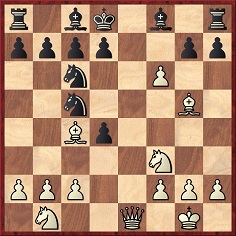
Edward Winter
Miniature games can be highly instructive because they demonstrate crime and punishment in drastic, not to say sadistic, form. Many spectacular brevities have been published over and over, but here we examine a few that the anthologists have neglected.
The first is taken from pages 27-28 of a book published in Mexico in 1893, Un poco de ajedrez by Manuel Márquez Sterling (1872-1934), and it shows the author in action.
Manuel Márquez Sterling – N.N.
Occasion?
(Remove White’s rook at a1.)
1 e4 e5 2 d4 exd4 3 Bc4 Nc6 4 Nf3 Nf6 5 e5 Qe7 6 O-O Ne4 7 Re1 Nc5 8 Bg5 f6 9 exf6 Qxe1+ 10 Qxe1+ Kd8 (Márquez Sterling notes that Black should have played 10...Ne6.)

11 Qe8+ Kxe8 12 f7 mate.
In the next game, a typical miniature, White sacrifices a pawn at move eight to gain time (by wrong-footing the black queen) and to build up a powerful attack.
George H. Wolbrecht – Henry Fowler Lee
Chicago, 1906
Sicilian Defence
1 e4 c5 2 Nc3 Nc6 3 Nf3 Nf6 4 d4 cxd4 5 Nxd4 e6 6 Be3 Bb4 7 Bd3 Qa5 8 O-O Bxc3 9 bxc3 Qxc3 10 Nb5 Qe5 11 f4 Qb8 12 e5 Nd5 13 Nd6+ Kf8 14 Bc5 Kg8 15 Qh5 Nd8
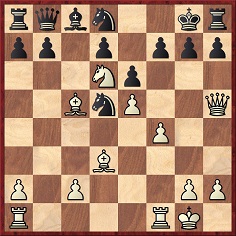
16 Ne8 (One threat now is 17 Bd6 Nc7 18 Bxc7, winning the queen.) 16...b6 17 Qg5 g6 18 Qh6 Black resigns. It is mate next move.
Source: American Chess Bulletin, September 1906, page 185.
A queen stifled by a bishop is also an eventuality in the game below, in which White plays the opening far too passively:
Josef Michló – Robert Pikler
Budapest, 6 May 1931
Caro-Kann Defence
1 d4 c6 2 e4 d5 3 exd5 cxd5 4 Nd2 Bf5 5 Ngf3 Nc6 6 c3 Nf6 7 Be2 Qc7 8 O-O e6 9 Re1 Bd6 10 h3 O-O 11 Nh4 (The tournament book recommends 11 Nfl.)
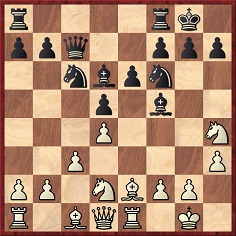
11...Nxd4 (If now 12 cxd4 then 12...Bc2, the ‘Rubinstein trap’.) 12 Nxf5 Nxf5 13 Nf3 Bc5 14 g4 (White suddenly becomes reckless.) 14...Bxf2+ 15 Kxf2 Qg3 16 Kf1 Ne4 17 White resigns. (He has no reasonable way of stopping 17...Qf2 mate.)
Even a leading master will occasionally be on the sharp end of a miniature. Carl Schlechter’s quick defeat against a lesser light comes from pages 108-109 of the April 1904 Deutsche Schachzeitung.
Carl Schlechter – Hugo Fähndrich
Vienna, 29 October 1903
Ruy López
1 e4 e5 2 Nf3 Nc6 3 Bb5 a6 4 Ba4 Nf6 5 O-O Nxe4 6 d4 b5 7 Bb3 d5 8 dxe5 Be6 9 c3 Bc5 10 a4 Rb8 11 axb5 axb5 12 Nd4 Nxe5 13 Bf4 Ng6 14 Nc6 Qf6 15 Be3 Nh4 16 Bxc5
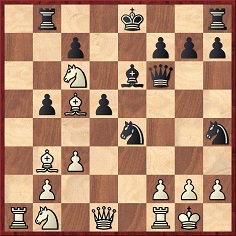
16...Bh3 17 gxh3 (But not, the Deutsche Schachzeitung says, 17 Qxd5 Nf3+ 18 Kh1 Bxg2+ 19 Kxg2 Nh4+ 20 Kh3 Qf3+ 21 Kxh4 g5+, and Black wins.) 17...Qxc6 18 Bd4 (Here the German magazine recommends 18 Qh5 Nxc5 19 Re1+ Kf8 20 Qxh4 Nxb3 21 Qe7+ Kg8 22 Ra6 Qc5 23 Qd7 h5 24 Rc6 Qf8 25 Rxc7 Rh6 26 Re7.) 18...h5 (To enable the black queen to give check on the g-file without White’s queen being able to interpose at g4.) 19 Kh1 Qg6 20 Rg1 Nxf2+ 21 White resigns. (After 21 Bxf2, Black wins with 21...Qe4+.)
The above games were given on pages 126-128 of Kings, Commoners and Knaves. See also the section entitled ‘Brevities’ (C.N. 931) on page 50 of Chess Explorations, which presented five games: J. Lokvenc v L. Pachman, Prague, 1943; E. Lundin v F. Ekström, Stockholm, 1947; A. Mengarini v Ervin, Lone Pine, 1971; A. Mengarini v Kramer, New York, 1973; R. Chalker v S. Bernstein, New York, 1976.
A 1934 match-game between Llorens v Ticoulat from page 277 of the Australasian Chess Review, 25 September 1934:
1 d4 d5 2 c4 e6 3 Nc3 Nf6 4 Bg5 Nbd7 5 e3 c6 6 Nf3 Qa5 7 cxd5 Ne4 8 Nd2 Nxg5 9 dxc6 Nf6 10 Bb5 b6 11 a3 Nge4 12 c7+ Bd7 13 Nc4 Nxc3 14 Qf3 Qxb5 15 Qxa8+ Ke7 16 Qd8 mate.
(61)
From page 47 of the December 1944 CHESS:
M. Ellinger – Rev. A.P. Durrant
P.C.C. League tournament No. 14
Sicilian Defence
1 e4 c5 2 Ne2 Nf6 3 e5 Nd5 4 c4 Nb4 5 Nbc3 Nd3 mate.
‘Rarely can Mr Ellinger, a normally very sound and strong player, have gone so badly astray!’
(1045)
George Brunton Fraser – Wilhelm Steinitz
Sixth match-game, Dundee, 1867
(Remove Black’s f-pawn.)
1 e4 e6 2 d4 Qe7 3 Bd3 Nc6 4 Nf3 b6 5 O-O Bb7 6 d5 Nd8 7 Bg5 Qf7 8 Ne5 Resigns.
Source: volume one of Bachmann’s Schachmeister Steinitz, page 182.
(1216)
It is frequently stated that Rudolf Spielmann was very mild-mannered, in stark contrast to his fiery attacking style over the board. On page 199 of the September 1981 CHESS Euwe described him as follows: ‘Very pleasant, though a little inclined to complain about things. He has often stayed with me. He was rather a dreamer ...’
One novel complaint made by Spielmann (according to page 18 of P. Michel’s Lachaga book on Dortmund, 1928) arose from his loss to Bogoljubow in the third round of that tournament. The trouble was that in round four Bogoljubow proceeded to lose recklessly to Dr Alfred van Nüss. Spielmann was not slow to see a malevolent pattern:
‘I am bound to believe that it is only against me that opponents display their full strength.’
In round two Spielmann had only himself to blame:
Rudolf Spielmann – Richard Réti
Dortmund, 28 July 1928
Vienna Game
1 e4 e5 2 Bc4 Nf6 3 d3 Nc6 4 Nc3 Bb4 5 Ne2 d5 6 exd5 Nxd5 7 Bxd5 Qxd5 8 O-O Qa5 9 a3 O-O 10 Be3 Bxc3 11 Nxc3 Nd4 12 b4 Qa6 13 f4 Qc6 14 Qd2 Qxc3 15 White resigns.
Master chess contains few moves to compare with White’s 14th.
(1539)
The earlier French version of Euwe’s remarks about Spielmann quoted above:
‘Très gentil et un peu enclin à se plaindre. Il a souvent logé chez nous. Il avait un air un peu bizarre; enfant, il était tombé sur la tête ..’
Source: Europe Echecs, August 1981, page 372 (interview translated from the Dutch by J. Marguillier). The original Dutch version was published in the May 1981 issue of Schakend Nederland.
An endnote on page 259 of Chess Explorations:
C.N. 173 pointed out that Spielmann once lost 12 games in a tournament (Carlsbad, 1923).
Gordon Pollard (Wallingford, England) writes:
‘While looking through Spielmann’s games I noticed that Spence (volume two, page 81) says that Spielmann v Johner, Pistyan, 1922 escaped much publicity at the time; but the BCM published it (August 1922, page 312) and I have it in a newspaper cutting pasted into my schoolboy notebook. Spence and the BCM give Johner’s iniital as “S.”, but my cutting shows “P.”, and reference to Gaige’s Catalog suggests that his name was Paul.
R. Spielmann-P. Johner, Pistyan, 1922. Vienna Game.
1 e4 e5 2 Nc3 Nf6 3 f4 d5 4 fxe5 Nxe4 5 Nf3 Be7 6 d4 O-O 7 Bd3 f5 8 exf6 Nxf6 9 O-O Nc6 10 Bg5 Bg4 11 Qe1 h6 12 Bxh6 gxh6 13 Qg3 Bd6 14 Ne5 Qe7 15 Nxd5 Nxd5 16 Qxg4+ Qg7 17 Qe6+ Kh8 18 Rf7 Resigns.
Spence demonstrates a win for White after 18...Rxf7 but does not mention 18...Nf4, threatening mate. Now if 19 Ng6+ then 19...Qxg6 and Black wins. White’s best seems to be 19 Rxf4, when after 19...Bxe5 20 Rxf8+ Rxf8 21 dxe5 Nxe5 a win for White is not readily demonstrable. This is perhaps another instance of premature resignation.’
A few comments of our own:
i) That Black was Paul (as opposed to Hans) Johner is confirmed by the tournament book. We know of no S. Johner.
ii) The game may have received little publicity because the tournament book (page 149) castigated White’s 12th move. Moreover, it gave 14...Qe7 a double question mark, recommending 14...Nxd4 15 h3 Qe7 as a way of curbing the attack. The BCM awarded 12 Bxh6 an exclamation mark.
iii) Although the BCM and, for instance, Chess, More Miniature Games by J. du Mont (page 74) give 16...Qg7, the tournament book records that Black played 16...Qg5. If 16...Qg5 was the move played, then 18...Nf4 would leave open a mate in one.
(1563)
Pages 55-56 of Czerniak’s book on Buenos Aires, 1939 (not the Olympiad) give this miniature:
Luis Palau – M. Najdorf
Buenos Aires, October 1939
Sicilian Defence
1 e4 c5 2 Nc3 Nc6 3 g3 g6 4 Bg2 Bg7 5 Nge2 e6 6 d3 Nge7 7 Be3 Nd4 8 Qd2 Qa5 9 f4 d6 10 b4 Qxb4 11 Rb1 Nxe2 12 White resigns.
Although it can be retorted that the ability to play sans voir is no measure of world-beating chess skill, it remains an arresting and inconvenient truth that a forgotten nineteenth-century player such as Alexander Fritz (1857-1932) could play 12 blindfold games simultaneously, a feat that would, at least, stretch most of today’s masters. A report of Fritz’s exploits appeared on page 172 of the June 1880 Deutsche Schachzeitung, and below is one of his games, also forgotten, from a four-board blindfold exhibition.
Alexander Fritz (blindfold) – A. Hensel
Darmstadt, September 1877
Sicilian Defence
1 e4 c5 2 d4 d6 3 Nf3 Nf6 4 Nc3 cxd4 5 Nxd4 e5 6 Bb5+ Bd7 7 Nf5 Nc6 8 Nxd6+ Bxd6 9 Qxd6 a6 10 Bg5 h6
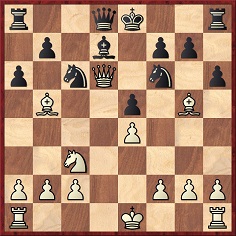
11 Nd5 Rc8 12 Bxf6 Qa5+ 13 c3 Qxb5 14 O-O-O Be6 15 Nc7+ Rxc7 16 Qd8+ Nxd8 17 Rxd8 mate.
Source: Deutsche Schachzeitung, October-November 1878, pages 336-337.
(Chess Café, 1997)
Sir George Thomas once lost a game in 13 moves to the tournament tail-ender:
George Alan Thomas – Theodore Henry Tylor
Weston-super-Mare, 7 April 1926
Queen’s Gambit Declined
1 d4 d5 2 c4 e6 3 Nf3 c6 4 Nc3 Nf6 5 e3 Ne4 6 Bd3 f5 7 O-O Nd7 8 Ne1 Bd6 9 Bxe4 fxe4 10 Qh5+ g6 11 Qh6 Bf8 12 Qf4 Nf6 13 f3 Nh5 14 White resigns.
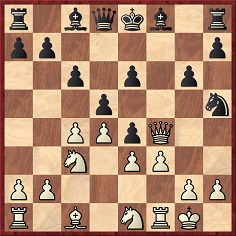
Source: BCM, May 1926, page 212.
(Kingpin, 1998)
Page 109 of the 1 May 1947 Chess World reported:
‘The Adelaide player F. Villner claims a world’s record: shortest game ever won by a player receiving odds in a tournament. The game was played in a lightning tourney in Sweden, the time-limit being three seconds a move.’
Black, who played without his f-pawn, was not named. The moves were 1 d4 Nc6 2 e4 Nh6 (‘Aiming at f7, a recognized development at these odds, but not after White has played d4.’) 3 Bxh6 gxh6 4 Qh5 mate.
(5362)
To the Chess Notes main page.
To the Archives for other feature articles.
Copyright: Edward Winter. All rights reserved.